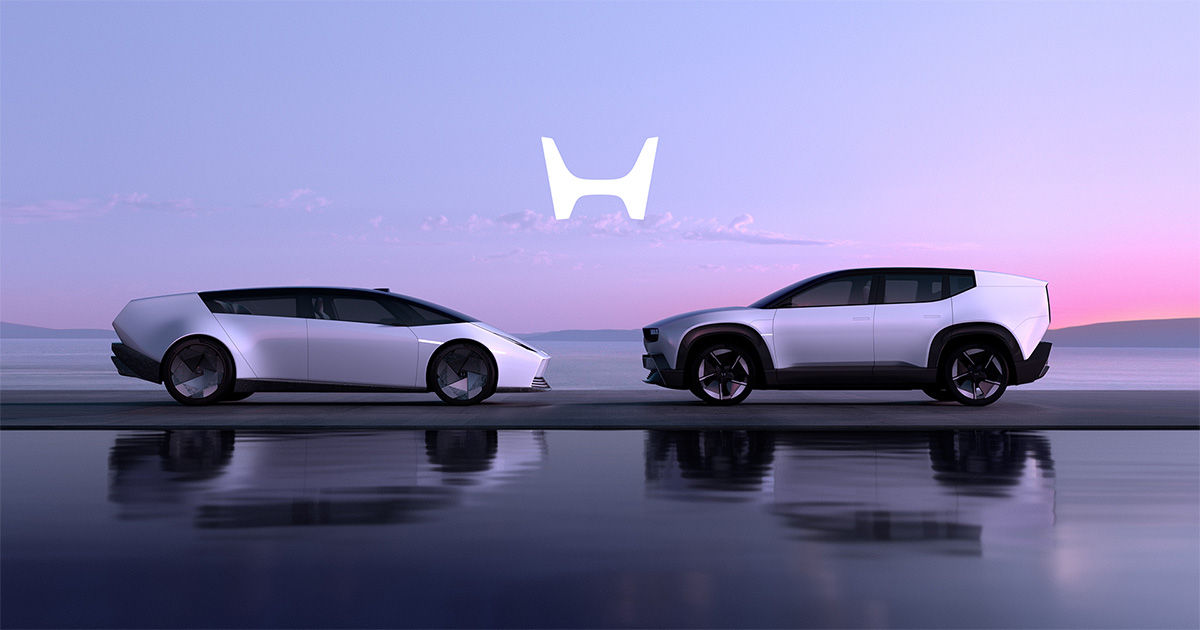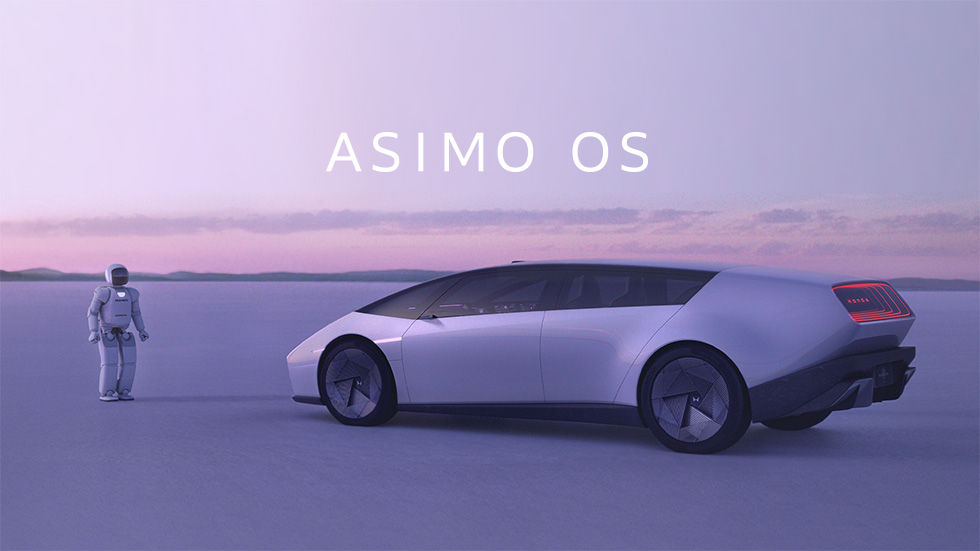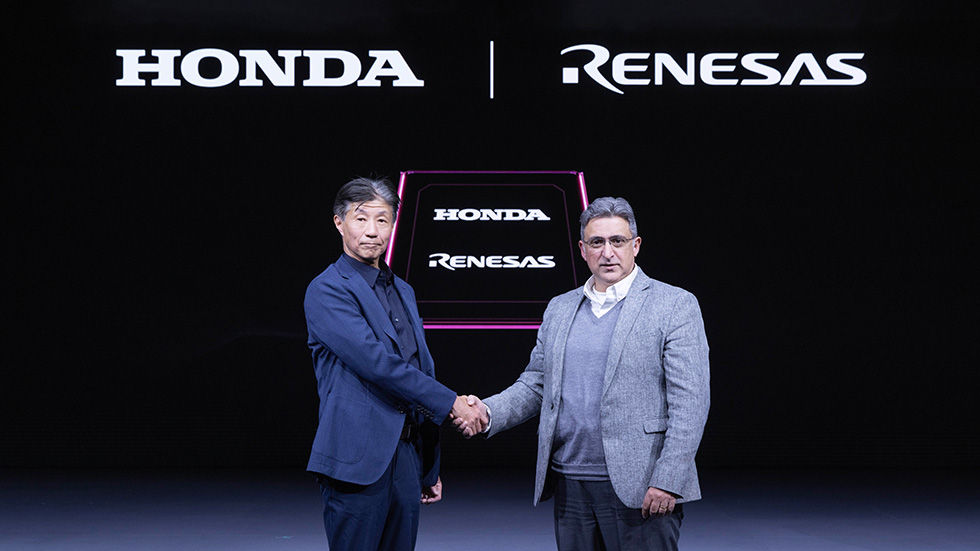Honda today presented the world premiere of two prototype models at CES 2025, Honda 0 Saloon and Honda 0 SUV, representing two Honda 0 Series models that will be introduced to global markets starting in 2026. Honda also introduced its original vehicle operating system (OS), the ASIMO OS, for Honda 0 Series models.

Honda 0 Saloon
By further advancing the concept model introduced last year at CES 2024, the Honda 0 Saloon prototype was developed in preparation for a market launch scheduled in 2026. While maintaining the exact styling design of the concept model, the prototype model features both a low height, sporty styling that sets the Saloon apart from other EVs at first glance and an interior space that is more spacious than people can imagine based on the exterior dimensions.
The Honda 0 Saloon, the flagship model of the Honda 0 Series, will be based on the newly-developed dedicated EV architecture and will feature a number of next-generation technologies that will embody the “Thin, Light, and Wise” development approach of the Honda 0 Series.
At CES 2025, Honda is focusing on introducing certain technologies and features that contribute to the “Wise” value of the Honda 0 Saloon. This includes the highly reliable automated driving technologies backed by the Level 3 automated driving technology, which Honda put into practical use for the first time in the world, as well as “ultra-personal optimization” that will offer a mobility experience customized for each individual user, which will become possible with the ASIMO OS.
The production model of the Honda 0 Saloon is scheduled to be introduced first in the North American market in 2026, then in global markets, including Japan and Europe.
Honda 0 Series | WISE EXPERIENCE https://youtu.be/MW86NBIXIUw

Honda 0 SUV
Based on the Space-Hub concept model unveiled at CES 2024, proposing the new value of EVs as a “space” for people that Honda wants to offer with its future EV models, Honda presented the prototype of a mid-size EV SUV, which will be the first Honda 0 Series model. By applying the “Thin, Light, and Wise” approach to an SUV, the interior space was further increased, and a spacious cabin was achieved with an outstandingly clear and unrestricted field of view and great flexibility.
As with the Honda 0 Saloon, the Honda 0 SUV will feature a wide variety of next-generation technologies which embody the “Thin, Light, and Wise” development approach of the Honda 0 Series. This model will offer the value of an “ever-advancing” space through the “ultra-personal optimization” and digital UX made possible by the ASIMO OS. Moreover, the Honda 0 SUV will apply high-precision attitude estimation and stabilization control based on 3D gyro sensors, technology Honda has amassed through the development of its original robotics technologies, to enable dynamics at the will of the driver on various types of road surfaces.
The production model of the Honda 0 SUV is scheduled to be introduced first in North American market in the first half of 2026, then in global markets, including Japan and Europe.
Honda 0 SUV https://youtu.be/4sIFhyG6cLc

ASIMO OS
Honda 0 Series models will be equipped with the ASIMO OS, an original vehicle OS developed by Honda. ASIMO was a humanoid robot capable of autonomous walking, developed as part of Honda fundamental technology research with the aim of helping people while coexisting with people in society. Honda began robotics research and development in 1986, and introduced ASIMO in 2000. ASIMO became an icon in the field of robotics from the 2000s through 2010s and was loved by people all over the world for a long period of time thereafter.
Honda gave the name ASIMO to this vehicle OS, the core technology to achieve the “Wise” value of the Honda 0 Series, with a determination to strive for making Honda 0 Series an icon of next-generation EVs, which will surprise and inspire people all around the world, just as ASIMO did.

Even after development of ASIMO, Honda has been further advancing its robotics technologies, such as ASIMO technologies that recognize external environments and autonomous behavior control technologies that enable ASIMO to act while understanding the intentions of people around it. By combining such robotics technologies with advanced intelligence technologies for the Honda 0 Series, Honda strives to offer the value of software defined vehicles (SDVs) unique only to Honda.
As a software platform, ASIMO OS will apply integrated control of electronic control units (ECUs) for vehicle systems such as automated driving/advanced driver assistance systems (AD/ADAS) and in-vehicle infotainment (IVI) system.
By constantly updating the in-vehicle software based on the ASIMO OS through over the air (OTA) updates even after the purchase of the vehicle, functions and services will be continuously advanced in accordance with the preferences and needs of each individual user. The functions and services subject to constant updates include those which enhance the value of “space” and the digital UX, that ensures fun and comfortable mobility experience, and integrated control of dynamics unique to Honda, that determines the joy of driving, enabling the driver to feel at one with the vehicle.
Honda is planning to install ASIMO OS to Honda 0 Series models, including production models of the Honda 0 SUV and Honda 0 Saloon.
Automated driving (AD) technology
In 2021, Honda became the world’s first automaker to put Level 3 automated driving equipment into practical use with the launch of the all-new Legend equipped with Honda SENSING Elite, which qualified for Level 3 automated driving (eyes-off), and conditional driving automation in limited areas.
Honda developed Honda SENSING Elite to put this AD technology into practical use by anticipating all driving conditions and scenarios based on the premise that, in addition to reducing the number of traffic collisions in society, Honda AD must completely eliminate traffic accidents that people think a “human driver could avoid.”
Honda believes that the widespread use of eyes-off technology will lead toward the realization of zero traffic collision fatalities in the future. Based on this belief, Honda will strive to offer affordable automated driving vehicles to more customers around the world through the Honda 0 Series.
To this end, Honda applies an original Honda AI technology that combines the unsupervised learning*1technology of Helm.ai and the behavior models of experienced drivers, which enable AI to learn with smaller amounts of data, and efficiently expand the range of situations where automated driving and driver assistance can be available.
In addition, Honda will apply its original cooperative AI developed through research into people and mobility to further improve the precision of cooperative behavior, such as yielding the right of way to others on the road, which is difficult even for a human driver. By applying these advanced technologies, Honda will realize a highly-reliable driver assistance system that can respond quickly and appropriately to unexpected situations, such as an animal darting into the lane or an object falling onto the road.
Honda 0 Series models will be equipped with a system that enables the expansion of the range of driving conditions where driver assistance and Level 3 automated driving will be available. This expansion will start with eyes-off technology available in traffic congestion on highways, then will continue through the OTA updates of the functions.
With Level 3 automated driving, the vehicle will be in charge of driving, which will enable a human driver to perform a “second task” while en route to their destination, whether watching a movie or remotely joining a meeting. Honda will further advance its technologies and become the first automaker to expand the application of eyes-off functions to all driving situations, opening up new possibilities for mobility.
Development of SoC dedicated to Honda 0 Series
At the Honda press conference held at CES 2025, Honda and Renesas Electronics Corporation (Renesas) announced that they have signed an agreement to develop a high-performance system-on-chip (SoC) to realize the future SDVs Honda aims to achieve with Honda 0 Series models.

For the next-generation Honda 0 Series models, which will be launched in the late 2020s, Honda will adopt a centralized E&E architecture that combines multiple ECUs, responsible for controlling vehicle systems, into a single, core ECU. The core ECU, which serves as the heart of the SDV, manages various vehicle systems, such as AD/ADAS, powertrain control, and comfort features, all on a single ECU. To achieve this, the ECU requires a SoC that provides higher processing performance than traditional systems, while minimizing any increase in power consumption.
To fulfill such requirements, Honda and Renesas will realize a system that utilizes multi-die chiplet technology*2 to combine the Renesas generic fifth-generation (Gen 5) R-Car X5 SoC series with an AI accelerator optimized for AI software developed independently by Honda. With this combination, the two companies aim to develop a system that achieves one of the industry’s top class AI performances of 2,000 TOPS*3 (Sparse) with 20 TOPS/W power efficiency.
Energy Service
In order to offer Honda 0 Series models that achieve the joy and freedom of mobility for more people with zero environmental impact, Honda will develop and offer new energy services based on two core concepts: 1) building a charging network that enables the customers to enjoy stress-free freedom of mobility and 2) enabling people to enjoy clean and smart daily lives utilizing EV batteries.
As for the establishment of the charging network, Honda is striving to realize a society where 0 Series users will never have trouble recharging their vehicles. To this end, in North America, eight automakers*4 established a joint venture to create a charging network called IONNA. It aims to include at least 30,000 high-quality charging stations by 2030. In addition, by adopting the North American Charging Standard (NACS) for the charging port of Honda 0 Series models, Honda will continue making progress in expanding the charging network to ensure that Honda 0 Series owners will have access to more than 100,000 charging stations by 2030.
Moreover, in line with the introduction of Honda 0 Series models, Honda is also considering a new charging service that leverages this broad charging network. By incorporating Amazon Web Services, Inc.(AWS)technologies, such as Amazon Bedrock, the generative AI technology of AWS, into Honda intelligent technology, and by analyzing data obtained from the Honda 0 Series and the extensive charging network, Honda will strive to provide a personalized charging experience for each individual in terms of finding charging facilities and simplifying payment.
In order to achieve carbon neutrality, it is essential to further utilize renewable energy along with popularization of EVs. For home charging, which is expected to account for approximately 80% of all EV charging*5, Honda will further advance the Honda Smart Charge, a charging service for EV owners, which Honda is currently offering in North America, by combining the Home Energy Management System Honda is co-developing with Emporia Corp., with the Vehicle Grid Integration (VGI) system of ChargeScape, a software JV that Honda established with BMW and Ford. Through these initiatives, Honda will start offering new services that contribute to reducing electricity costs and CO2 emissions for our customers in North America and other markets starting in 2026.
With this service, the collective fleet of Honda 0 Series models will also serve as a virtual power plant (VPP) and execute a personalized charging plan for each user. To be more specific, a Honda 0 Series model will charge itself by selecting times of the day when electricity costs are low and renewable energy can be utilized, and discharge the electricity for household use during times when electricity costs are high, thereby wisely managing the entire household’s electricity bill.
Furthermore, when electricity is in short supply, the electricity stored in Honda 0 Series models can be supplied to the power grid, thereby contributing to the stabilization of electricity supply and enabling owners to gain some income from their EVs. Battery degradation, which can be a concern due to repeated charging and discharging, is also minimized through the use of battery management technology Honda has amassed through the development of hybrid-electric vehicles.
(1) Unsupervised learning is one of the methods of machine learning, which supports AI. Unlike supervised learning through which AI learns the correct answers to derive from labeled input data, unsupervised learning lets AI learn without being provided with the correct answers and derives the patterns and unique characteristics of the unlabeled data on its own.
(2) Technology to build a system by combining multiple chips (dies) with different functions
(3) Tera Operations Per Second (TOPS) is a metric of AI processing performance and measures the number of operations that can be performed per second. Based on a sparse AI model.
(4) American Honda Motor, a Honda subsidiary in the U.S., BMW Group, General Motors, Hyundai Motors, Kia Corporation, Mercedes-Benz Group, Stellantis N.V., Toyota Motor.
(5) Honda internal research
Honda press conference at CES 2025 (livestreaming/archive)
https://youtube.com/live/3M87dqNbY3U


